Chapter: Business Science : International Business Management : Conflict Management and Ethics in International Business Management
Negotiation
NEGOTIATION
Negotiation is a dialogue intended to resolve
disputes, to produce an agreement upon courses
of action, to bargain for individual or collective advantage, or to craft
outcomes to satisfy various interests. It is the primary method of alternative
dispute resolution.
Negotiation
occurs in business, non-profit organizations and government branches, legal
proceedings, among nations and in personal situations such as marriage,
divorce, parenting, and everyday life.
Etymology
The word
"negotiation" is from the Latin expression, "negotiatus",
past participle of negotiate which means "to carry on business".
Another view of negotiation comprises 4 elements:
Strategy,
process and tools, and tactics. Strategy comprises the top level goals -
typically including relationship and the final outcome. Processes and tools
include the steps that will be followed and the roles taken in both preparing
for and negotiating with the other parties. Tactics include more detailed
statements and actions and responses to others' statements and actions.
Approaches to negotiation
The advocate's approach
In the
advocacy approach, a skilled negotiator usually serves as advocate for one
party to the negotiation and attempts to obtain the most favorable outcomes
possible for that party. In this process the negotiator attempts to determine
the minimum outcome(s) the other party is (or parties are) willing to accept,
then adjusts their demands accordingly. A "successful" negotiation in
the advocacy approach is when the negotiator is able to obtain all or most of
the outcomes their party desires, but without driving the other party to
permanently break off negotiations, unless the best alternative to a negotiated
agreement (BATNA) is acceptable.
Indeed, the ten new rules for global negotiations
advocated by Hernandez and Graham.
Accept only creative outcomes
Understand cultures, especially your own.
Don‘t just adjust to cultural differences, exploit
them.
Gather intelligence and reconnoiter the terrain.
Design the information flow and process of
meetings.
Invest in personal relationships.
Persuade with questions. Seek information and
understanding.
Make no concessions until the end.
Use techniques of creativity
10.Continue
creativity after negotiations
Emotion in negotiation
Emotions
play an important part in the negotiation process, although it is only in
recent years that their effect is being studied. Emotions have the potential to
play either a positive or negative role in negotiation. During negotiations,
the decision as to whether or not to settle rests in part on emotional factors.
Negative emotions can cause intense and even irrational behavior, and can cause
conflicts to escalate and negotiations to break down, while positive emotions
facilitate reaching an agreement and help to maximize joint gains.
Positive effect in negotiation
Even
before the negotiation process starts, people in a positive mood have more confidence,
and higher tendencies to plan to use a cooperative strategy. During the
negotiation, negotiators who are in a positive mood tend to enjoy the
interaction more, show less contentious behavior, use less aggressive tactics
and more cooperative strategies. This in turn increases the likelihood that
parties will reach their instrumental goals, and enhance the ability to find
integrative gains.
Indeed,
compared with negotiators with negative or natural affectivity, negotiators
with positive affectivity reached more agreements and tended to honor those
agreements more. Those favorable outcomes are due to better Decision Making
processes, such as flexible thinking, creative Problem Solving, respect for
others' perspectives, willingness to take risks and higher confidence.
Post
negotiation positive affect has beneficial consequences as well. It increases
satisfaction with achieved outcome and influences one‘s desire for future
interactions. The PA aroused by reaching an agreement facilitates the dyadic
relationship, which result in affective commitment that sets the stage for
subsequent interactions. PA also has its drawbacks: it distorts perception of
self performance, such that performance is judged to be relatively better than
it actually is. Thus, studies involving self reports on achieved outcomes might
be biased.
Negative effect in negotiation
Negative
effect has detrimental effects on various stages in the negotiation process.
Although various negative emotions affect negotiation outcomes, by far the most
researched is anger. Angry negotiators plan to use more competitive strategies
and to cooperate less, even before the negotiation starts. These competitive
strategies are related to reduce joint outcomes. During negotiations, anger
disrupts the process by reducing the level of trust, clouding parties'
judgment, narrowing parties' focus of attention and changing their central goal
from reaching agreement to retaliating against the other side. Angry
negotiators pay less attention to opponent‘s interests and are less accurate in
judging their interests, thus achieve lower joint gains.
Moreover,
because anger makes negotiators more self-centered in their preferences, it
increases the likelihood that they will reject profitable offers. Anger doesn‘t
help in achieving negotiation goals either: it reduces joint gains and does not
help to boost personal gains, as angry negotiators don‘t succeed in claiming
more for themselves. Moreover, negative emotions leads to acceptance of
settlements that are not in the positive utility function but rather have a
negative utility. However, expression of negative emotions during negotiation
can sometimes be beneficial: legitimately expressed anger can be an effective
way to show one's commitment, sincerity, and needs.
Moreover,
although NA reduces gains in integrative tasks, it is a better strategy than PA
in distributive tasks (such as zero-sum). In his work on negative affect
arousal and white noise, Seidner found support for the existence of a negative
affect arousal mechanism through observations regarding the devaluation of
speakers from other ethnic origins." Negotiation may be negatively
affected, in turn, by submerged hostility toward an ethnic or gender group.
Conditions for emotion effect in negotiation
Research
indicates that negotiator‘s emotions do not necessarily affect the negotiation
process. Albarracın et al. (2003) suggested that there are two conditions for
emotional effect, both related to the ability (presence of environmental or
cognitive disturbances) and the motivation:
Identification of the affect: requires high
motivation, high ability or both.
Determination that the affect is relevant and
important for the judgment: requires that either the motivation, the ability or
both are low.
According
to this model, emotions are expected to affect negotiations only when one is
high and the other is low. When both ability and motivation are low the affect
will not be identified, and when both are high the affect will be identify but
discounted as irrelevant for judgment. A possible implication of this model is,
for example, that the positive effects PA has on negotiations (as described
above) will be seen only when either motivation or ability are low.
Cultural
differences cause four kinds of problems in international business
negotiations, at the levels of:
Language
Nonverbal
behaviors
Values
Thinking
and decision-making processes
The order
is important; the problems lower on the list are more serious because they are
more subtle. For example, two negotiators would notice immediately if one were
speaking Japanese and the other German. The solution to the problem may be as
simple as hiring an interpreter or talking in a common third language, or it
may be as difficult as learning a language. Regardless of the solution, the
problem is obvious.
Nonverbal Behaviors
Anthropologist
Ray L. Birdwhistell demonstrated that less than 35% of the message in
conversations is conveyed by the spoken word while the other 65% is
communicated nonverbally. Albert Mehrabian, a UCLA psychologist, also parsed
where meaning comes from in face-to-face interactions. He reports:
7% of the
meaning is derived from the words spoken
38% from
paralinguistic channels, that is, tone of voice, loudness, and other aspects of
how things are said 55% from facial
expressions
Of
course, some might quibble with the exact percentages (and many have), but our
work also supports the notion that nonverbal behaviors are crucial – how things
are said is often more important than what is said.
Exhibit 2
provides analyses of some linguistic aspects and nonverbal behaviors for the 15
videotaped groups, that is, how things are said. Although these efforts merely
scratch the surface of these kinds of behavioral analyses, they still provide
indications of substantial cultural differences.
Differences in managerial values as pertinent to
negotiations
Four
managerial values objectivity, competitiveness, equality, and punctuality that
are held strongly and deeply by most Americans seem to frequently cause misunderstandings
and bad feelings in international business negotiations.
Objectivity
Americans
make decisions based upon the bottom line and on cold, hard facts. Americans
don‘t play favorites. Economics and performance count, not people. Business is
business. Such statements well reflect American notions of the importance of
objectivity.
The
single most successful book on the topic of negotiation, Getting to Yes, is
highly recommended for both American and foreign readers. The latter will learn
not only about negotiations but, perhaps more important, about how Americans
think about negotiations. The authors are quite emphatic about separating the
people from the problem, and they state, every negotiator has two kinds of
interests: in the substance and in the relationship. This advice is probably
quite worthwhile in the United States or perhaps in Germany, but in most places
in the world such advice is nonsense. In most places in the world, particularly
in collectivistic, high-context cultures, personalities and substance are not
separate issues and cannot be made so.
Competitiveness and Equality
Simulated
negotiations can be viewed as a kind of experimental economics wherein the
values of each participating cultural group are roughly reflected in the economic
outcomes. The simple simulation used in this part of our work represents the
essence of commercial negotiations it has both competitive and cooperative
aspects. At least 40 businesspeople from each culture played the same
buyer-seller game, negotiating over the prices of three products. Depending on
the agreement reached, the ―negotiation pie could be made larger through
cooperation (as high as $10,400 in joint profits) before it was divided between
the buyer and seller.
Time
Just make
them wait. Everyone else in the world knows that no negotiation tactic is more
useful with Americans, because no one places more value on time, no one has
less patience when things slow down, and no one looks at their wristwatches
more than Americans do. Edward T. Hall in his seminal writing is best at
explaining how the passage of time is viewed differently across cultures and
how these differences most often hurt Americans.
Differences in thinking and decision-making
processes
When
faced with a complex negotiation task, most Westerners (notice the
generalization here) divide the large task up into a series of smaller tasks.
Issues such as prices, delivery, warranty, and service contracts may be settled
one issue at a time, with the final agreement being the sum of the sequence of
smaller agreements. In Asia, however, a different approach is more often taken
wherein all the issues are discussed at once, in no apparent order, and
concessions are made on all issues at the end of the discussion. The Western
sequential approach and the Eastern holistic approach do not mix well.
Negotiation Theory
Common Assumptions of Most Theories
Negotiation
is a specialized and formal version of conflict resolution most frequently
employed when important issues must be agreed upon. Negotiation is necessary
when one party requires the other party's agreement to achieve its aim. The aim
of negotiating is to build a shared environment leading to longterm trust and
often involves a third, neutral party to extract the issues from the emotions
and keep the individuals concerned focused. It is a powerful method for
resolving conflict and requires skill and experience. Zartman defines
negotiation as "a process of combining conflicting positions into a common
position under a decision rule of unanimity, a phenomenon in which the outcome
is determined by the process."
However,
most theories of negotiations share the notion of negotiations as a process.
Yet, they differ in their description of the process. Structural Analysis
considers this process to be a power game. Strategic analysis thinks of it as a
repetition of games (Game Theory). Integrative Analysis prefers the more
intuitive notion of process, in which negotiations undergo successive stages,
e.g. pre-negotiation, stalemate, settlement. Especially structural, strategic
and procedural analysis build on rational actors, who are able to prioritize
clear goals, are able to make trade-offs between conflicting values, are
consistent in their behavioral pattern, and are able to take uncertainty into
account.
Negotiations
differ from mere coercion, in that negotiating parties have the theoretic
possibility to withdraw from negotiations. It is easier to study bi-lateral
negotiations, as opposed to multilateral negotiations.
Structural Analysis
Structural
Analysis is based on a distribution of empowering elements among two
negotiating parties. Structural theory moves away from traditional Realist
notions of power in that it does not only consider power to be a possession,
manifested for example in economic or military resources, but also thinks of
power as a relation.
Based on
the distribution of elements, in structural analysis we find either
power-symmetry between equally strong parties or power-asymmetry between a
stronger and a weaker party. All elements from which the respective parties can
draw power constitute
Structure.
They may be of material nature, i.e. hard power, (such as weapons) or of social
nature, i.e. soft power, (such as norms, contracts or precedents). These
instrumental elements of power, are either defined as parties‘relative position
(resources position) or as their relative ability to make their options
prevail. Structural analysis is easy to criticize, because it predicts that the
strongest will always win. This, however, does not always hold true.
Strategic Analysis
According
to structural analysis, negotiations can therefore be described with matrices,
such as the Prisoner's Dilemma, a concept taken from Game Theory. Another
common game is the Chicken Dilemma.
Strategic
analysis starts with the assumption that both parties have a veto. Thus, in
essence, negotiating parties can cooperate (C) or defect (D). Structural
analysis then evaluates possible outcomes of negotiations (C, C; C, D; D, D; D,
C), by assigning values to each of the possible outcomes. Often, co-operation
of both sides yields the best outcome. The basic problem however is that the
parties can never be sure that the other is going to cooperate, mainly because
of two reasons: first, decisions are made at the same time or, second,
concessions of one side might not be returned. Therefore the parties have
contradicting incentives to cooperate or defect. If one party cooperates or
makes a concession and the other does not, the defecting party might relatively
gain more. Trust may be built only in repetitive games through the emergence of
reliable patterns of behavior such as tit-for-tat.
Process Analysis
Process
analysis is the theory closest to haggling. Parties start from two points and
converge through a series of concessions. As in strategic analysis, both sides
have a veto (e.g. sell, not sell; pay, not pay). Process analysis also features
structural assumptions, because one side may be weaker or stronger (e.g. more
eager to sell, not willing to pay a certain price). Process Analysis focuses on
the study of the dynamics of processes. E.g. both Zeuthen and Cross tried to
find a formula in order to predict the behaviour of the other party in finding
a rate of concession, in order to predict the likely outcome.
The
process of negotiation therefore is considered to unfold between fixed points:
starting point of discord, end point of convergence. The so called security
point, that is the result of optional withdrawal, is also taken into account.
Integrative Analysis
Integrative
analysis divides the process into successive stages, rather than talking about
fixed points. It extends analysis to pre-negotiations stages, in which parties
make first contacts. The outcome is explained as the performance of the actors
at different stages. Stages may include pre-negotiations, finding a formula of
distribution, crest behavior, settlement Disadvantages of International
Business – Conflict in International Business – Sources and Types of Conflict –
Conflict Resolutions – Negotiation – The Role of International Agencies –
Ethical Issues in International Buusiness – Ethical Decision-Making.
Contents
Conflict
in intern ational business Negotiation
International
business ethics
Conflict in Organizations:
Definition
Opposition
Incompatible
behavior Antagonistic inter action
Block
another party from reaching her or his goals
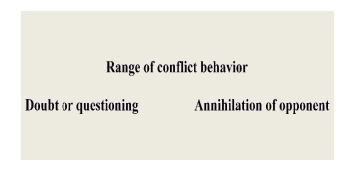
Key elements
Interdepen dence with another party
Perception of incompatible goals
Conflict events
Disagreem ents
o Debates
o Disputes
o Preventin g someone from reaching valued goals
Functional and Dysfunctional Conflict
Functional conflict: works
toward the goals of an organization or group
Dysfunctional conflict: blocks
an organization or group from reaching its goals
Dysfunctional
high conflict: what you typically think about conflict
Dysfunctional
low conflict: A typical view. Levels vary among groups
Functional conflict
“Constructive
Conflict”--Mary Parker Follett (1925) Increases information and ideas
Encourages
innovative thinking
Unshackles
different points of view
Reduces
stagnation
Dysfunctional high conflict
Tension,
anxiety, stress
Drives
out low conflict tolerant people Reduced trust
Poor
decisions because of withheld or distorted information Excessive management
focus on the conflict
Dysfunctional low conflict
Few new
ideas
Poor
decisions from lack of innovation and information Stagnation
Business
as usual
Levels and Types of Conflict
Level of conflict Type of
conflict
Organization Within
and between organizations
Group Within
and between groups
Individual Within
and between individuals
Levels and Types of Conflict
Intra-organization conflict
o Conflict
that occurs within an organization o At interfaces of organization functions
Can occur along the vertical and horizontal
dimensions of the organization
Vertical
conflict: between managers and subordinates
Horizontal
conflict: between departments and work groups
Intra-group conflict
Conflict
among members of a group Early stages of group development
Ways of
doing tasks or reaching group's goals
Intergroup conflict: between
two or more groups
Interpersonal conflict
Between
two or more people
Differences
in views about what should be done Efforts to get more resources
Differences
in orientation to work and time in different parts of an organization Intrapersonal conflict - Occurs within
an individual
Threat to
a person’s values
Feeling
of unfair treatment
Multiple
and contradictory sources of socialization
Related
to the Theory of Cognitive Dissonance and negative inequity
Inter-organization conflict
Between
two or more organizations Not competition
Examples:
suppliers and distributors, especially with the close links now possible
Conflict Episodes
Simple conflict episode
Latent
conflict
Manifest
conflict
Conflict
aftermath
Conflict
reduction
Latent conflict: antecedents of conflict behavior
that can start conflict episode Manifest
conflict: observable conflict behavior
Conflict aftermath
End of a
conflict episode
Often the
starting point of a related episode
Becomes
the latent conflict for another episode Conflict
reduction: lower the conflict level
Latent conflict
The
antecedents of conflict
Example:
scarce resources
Some
latent conflict in the lives of college students
Parking
spaces
Library
copying machines Computer laboratory
Books in
the bookstore
School
and other parts of your life University policies
Manifest conflict
Observable
conflict behavior
Example:
disagreement, discussion
Conflict aftermath
Residue
of a conflict episode
Example:
compromise in allocating scarce resources leaves both parties with less than
they wanted
Perceived conflict
o Become
aware that one is in conflict with another party o Can block out some conflict
o Can perceive conflict when no
latent conditions exist
o Example: misunderstanding another person’s
position on an issue
Felt conflict
o Emotional
part of conflict o Personalizing the conflict o Oral and physical hostility
o Hard to
manage episodes with high felt conflict o What people likely recall about conflict
Conflict Frames and Orientations
Conflict frame
Relationship-Task
Cooperate-Win
Emotional
Intellectual
Conflict frame dimensions
Relationship-Task
Relationship:
focuses on interpersonal relationships Task: focuses on material aspects of an
episode
Emotional-Intellectual
Emotional:
focuses on feelings in the conflict episode (felt conflict) Intellectual:
focuses on observed behavior (manifest conflict)
Cooperate-Win
Cooperate:
emphasizes the role of all parties to the conflict Win: wants to maximize
personal gain
Conflict frames
Limited
research results
End an
episode with a relationship or intellectual frame: feel good about relationship
with other party
Cooperation-focused
people end with more positive results than those focused on winning
Conflict orientations
Dominance:
wants to win; conflict is a battle
Collaborative:
wants to find a solution that satisfies everyone Compromise: splits the
differences
Avoidance:
backs away
Accommodative:
focuses on desires of other party
Reducing Conflict
Lose-lose
methods: parties to the conflict episode do not get what they want Win-lose
methods: one party a clear winner; other party a clear loser Win-win methods:
each party to the conflict episode gets what he or she wants Summary
Lose-lose
methods: compromise Win-lose methods: dominance
Win-win
methods: problem solving
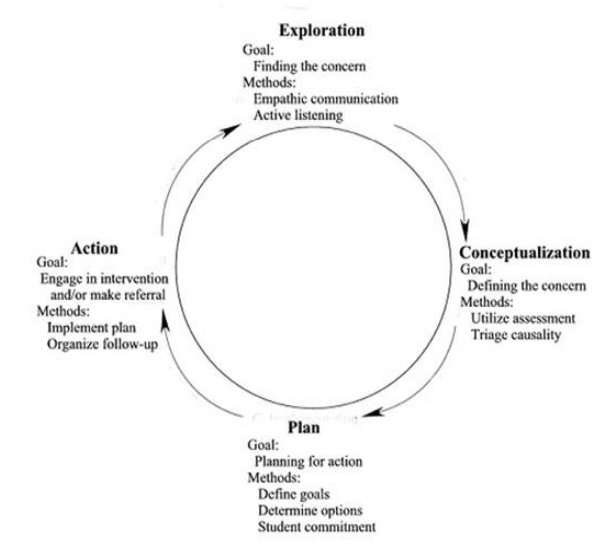
International Business Negotiation
Negotiation is the action and the process of
reaching an agreement by means of exchanging ideas with the intention of dispelling conflicts and enhancing
relationship to satisfy each other’s needs.
Characteristics of negotiation:
Every
negotiation involves two or more parties.
The
objective of a negotiation must be definite.
Negotiation
must be conducted on an equal basis.
A
consensus must be built on the basis of mutual concession.
Negotiation
involves exchange of ideas, communication, persuasion, compromise and suchlike
(process).
The Dual Concerns Model:
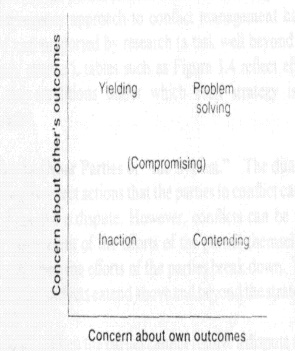
Business negotiation is a proce
ss of conferring in which the participants of business activities communicate, discuss, and adju st
their views, settle differences and finally reach a mutually acceptable
agreement in order to close a deal or achieve a proposed financial go al.
Characteristics of Business Ne gotiation:
The
objective of business negotiation is to obtain financial interest
The core
of business neg otiation is price
(3). Its
principle is equality and mutual benefit
(4).
Items of contract should keep strictly accurate and rigorous.
Principles of business negotiation:
Equality
principle
Cooperation
principle Flexibility principle
Positions-subjected-to-interests
principle
Depersonalizing
principl e (Separating the people from the problem) Using objective criterion
International Business Negotiation is the
business negotiation that takes p ace between the interest groups from different countries or regions.
Features of International Busi ness Negotiation:
Language
barrier
Cultural
differences
International
laws and domestic laws are both in force
International
political factors must be taken into account
The
difficulty and the cost are greater than that of domestic business negotiations
Forms of International Business Negotiation:
Classification
by chief negotiator Classification by negotiation object Classification by form
Classification by procedure
Classification by chief negotiator
Government-
to- government’s negotiation
Government-
to- Business’s negotiation
Producer-
to- Producer’s negotiation
Producer-
to- Trader’s negotiation
Retailer-
to -Producer’s negotiation
Business-
to- Business’s negotiation
Business-
to- Consumer’s negotiation
Classification by negotiation object
(1)Product
trade negotiation (2)Technology trade negotiation
Service
trade negotiation
International
project negotiation
Classification by form:
One- to-
one negotiation
Team
negotiation
Multilateral
negotiation
Classification by procedure
Horizontal
Negotiation
Vertical
Negotiation
The Basic Forms of International Business
Negotiation:
Host
Court” negotiation and “Guest Court” negotiation Oral negotiation and written
negotiation Formal and informal negotiation
“Host Court” negotiation and “Guest Court”
negotiation:
Host-
Court negotiation
Guest-
Court negotiation
Changing-
Court negotiation
Third-
place negotiation
Oral negotiation and written negotiation
Oral
negotiation
Written
negotiation
Formal and Informal negotiation:
Formal
negotiation
Informal
negotiation
International Negotiation:
More
complex than domestic negotiations
Differences
in national cultures and differences in political, legal, and economic systems
often separate potential business partners
Steps in the International Negotiation process
The successful international negotiator: personal
characteristics
Tolerance
of ambiguous situations Flexibility and creativity
Humor
Stamina Empathy Curiosity Bilingual
BASIC NEGOTIATION STRATEGIES:
Competitive
The negotiation as a win-lose game Problem solving
Search
for possible win-win situations
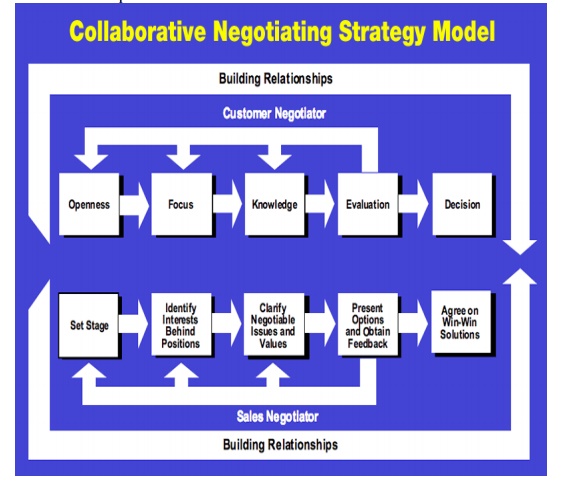

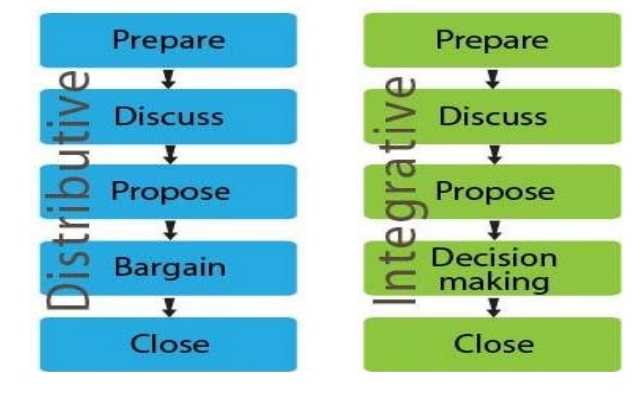
Related Topics